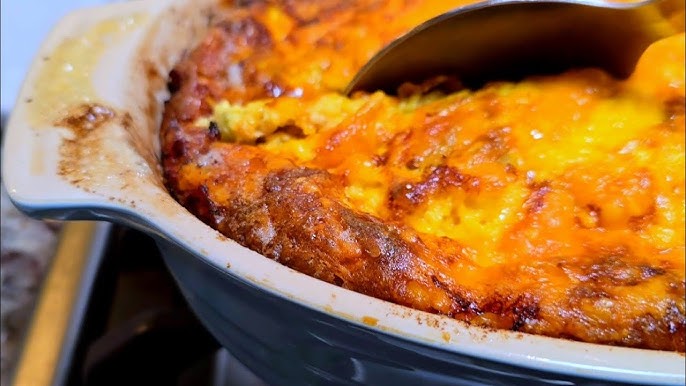Easy Breakfast Casserole Recipe: Breakfast is often called the most important meal of the day, and for good reason! It fuels your body and sets the tone for the hours ahead. But mornings can be hectic, and preparing a nutritious meal isn’t always easy. Enter the breakfast casserole—a one-dish wonder that’s hearty, versatile, and perfect for feeding a crowd or meal-prepping for the week.
This easy breakfast casserole recipe combines classic ingredients like eggs, bread, and cheese with optional add-ins to suit your taste. Whether you’re hosting brunch or just need a no-fuss breakfast option, this dish will become a staple in your kitchen.
Ingredients for the Easy Breakfast Casserole
Main Ingredients
- Eggs: The star of the dish, providing structure and protein.
- Bread or Potatoes: Choose crusty bread for a fluffy texture or hash browns for a hearty base.
- Milk or Cream: Adds creaminess to the casserole.
Optional Ingredients
- Meat: Crisp bacon, savory sausage, or diced ham add richness.
- Vegetables: Bell peppers, onions, and mushrooms bring flavor and nutrients.
- Cheese: Cheddar, mozzarella, or a mix for a gooey finish.
Tips for Ingredient Substitutions
- Want a vegetarian casserole? Skip the meat and load up on veggies.
- Need a gluten-free version? Use gluten-free bread or potatoes as a base.
- Dairy-free? Swap milk with almond or oat milk and use vegan cheese.
Essential Tools for Making a Breakfast Casserole
Before diving into the recipe, ensure you have these tools:
- Baking Dish: A 9×13-inch dish works best for this recipe.
- Mixing Bowls: For combining the egg mixture and other ingredients.
- Cooking Tools: A whisk, spatula, and cutting board will make prep a breeze.
Preparation Steps Before Cooking
Preheating the Oven
Start by preheating your oven to 375°F (190°C). A properly heated oven ensures even cooking and a golden-brown top.
Prepping Ingredients
- Cook the Meat: If using bacon or sausage, cook it until browned and crispy. Drain excess grease.
- Chop Vegetables: Dice peppers, onions, and mushrooms into small, even pieces for uniform cooking.
- Grate Cheese: Freshly grated cheese melts better than pre-shredded options.
Greasing the Baking Dish
Use butter, oil, or non-stick spray to coat the baking dish. This step prevents sticking and makes cleanup easier.
Step-by-Step Instructions
Step 1 – Mixing the Egg Mixture
In a large bowl, whisk together eggs, milk, salt, and pepper until well combined. For extra flavor, add a pinch of garlic powder or paprika.
Step 2 – Layering the Ingredients
Begin with a layer of bread or potatoes in the greased baking dish. Top with your choice of cooked meat, veggies, and half the cheese.
Step 3 – Pouring the Egg Mixture
Slowly pour the egg mixture over the layered ingredients, ensuring even coverage. Sprinkle the remaining cheese on top.
Step 4 – Baking the Casserole
Bake in the preheated oven for 35-40 minutes. The casserole is done when the center is set, and the top is golden brown.
How to Tell When the Casserole Is Done
- The edges should pull away slightly from the pan.
- A knife inserted into the center should come out clean.
- Use a thermometer to check that the internal temperature reaches 160°F (71°C).
Serving Suggestions
A breakfast casserole is a complete meal on its own, but pairing it with the right sides can elevate your dining experience. Here are some ideas:
- Fresh Fruits: A bowl of mixed berries, sliced oranges, or a fruit salad adds a refreshing balance to the rich casserole.
- Toast or Biscuits: Serve warm, buttered toast or flaky biscuits on the side for added comfort.
- Drinks: Complement your meal with freshly brewed coffee, tea, or a glass of orange juice.
For special occasions, consider adding a mimosa or a smoothie for a more festive touch.
Storing Leftovers
Breakfast casseroles are fantastic for leftovers because they reheat well and maintain their flavor. Follow these tips to store them:
- Refrigerating: Transfer leftovers to an airtight container or cover the baking dish with foil. Store in the refrigerator for up to 4 days.
- Freezing: Cut the casserole into individual portions and wrap them tightly in plastic wrap. Place the wrapped pieces in a freezer-safe bag or container. They’ll keep for up to 3 months.
- Reheating: For refrigerated portions, reheat in the oven at 350°F (175°C) for 10-15 minutes. Frozen portions can be reheated directly from the freezer but may take longer.
Make-Ahead Tips
If mornings are hectic, prepping your breakfast casserole in advance can be a lifesaver. Here’s how:
- Overnight Preparation: Assemble the casserole the night before, cover it with plastic wrap, and store it in the fridge. In the morning, remove the wrap and bake as instructed.
- Freezing for Later: Prepare the casserole, but don’t bake it. Cover it tightly and freeze for up to a month. Thaw in the refrigerator overnight before baking.
Variations of Breakfast Casseroles
The beauty of breakfast casseroles lies in their versatility. Here are some variations to try:
- Meat Lovers’ Casserole: Add a mix of cooked bacon, sausage, and diced ham for a protein-packed version.
- Vegetarian Delight: Skip the meat and load up on veggies like spinach, zucchini, and cherry tomatoes. Add feta cheese for extra flavor.
- Sweet Casserole: Swap savory ingredients for sweet ones. Use brioche or cinnamon bread, mix with a custard-like egg base, and top with fresh fruit or maple syrup.
Nutritional Information
Here’s an estimate of the nutritional content for one serving of this breakfast casserole (serving size: 1/8 of the dish):
| Nutrient | Amount |
|---|---|
| Calories | ~250-300 kcal |
| Protein | 12-15 g |
| Carbohydrates | 20-25 g |
| Fats | 10-15 g |
| Fiber | 2-4 g |
The values will vary depending on your ingredient choices and add-ins.
Common Mistakes to Avoid
Making a breakfast casserole isn’t complicated, but avoiding these pitfalls will ensure your dish turns out perfectly every time:
- Soggy Base: Overloading with wet ingredients, like overly juicy vegetables, can lead to a soggy casserole. Pat vegetables dry before adding.
- Uneven Cooking: Ensure all ingredients are evenly spread and precooked (especially meat) to avoid raw spots.
- Undercooking or Overcooking: Stick to recommended baking times and use a thermometer for precision.
Why You’ll Love This Recipe
This easy breakfast casserole ticks all the boxes. It’s:
- Quick to Assemble: Minimal prep work and one baking dish mean less time in the kitchen.
- Customizable: You can tweak the ingredients to suit your taste or dietary needs.
- Perfect for Any Occasion: Whether it’s a casual family breakfast or a festive brunch, this dish fits the bill.
FAQs about Easy Breakfast Casserole Recipe
1. What ingredients do I need for an easy breakfast casserole?
For a basic breakfast casserole, you’ll typically need eggs, milk, cheese, and bread. You can enhance it with extras like cooked sausage, bacon, diced vegetables, or herbs for more flavor.
2. Can I prepare the casserole the night before?
Yes, preparing your breakfast casserole the night before can save you time in the morning. Simply assemble the ingredients in a baking dish, cover it, and refrigerate overnight. Bake it in the morning as directed.
3. How long does it take to bake a breakfast casserole?
Most breakfast casseroles bake for about 45 minutes at 350 degrees Fahrenheit. However, the exact time can vary based on the size and depth of your dish.
4. Are there any vegetarian options for a breakfast casserole?
Absolutely! Substitute meat with vegetarian ingredients like mushrooms, bell peppers, onions, spinach, and use a plant-based milk alternative if desired.
5. Can I freeze a breakfast casserole?
Yes, you can freeze breakfast casseroles either before or after baking. Make sure to wrap it well to avoid freezer burn and consume within 2-3 months for best quality.
6. How can I make my breakfast casserole low carb?
For a low-carb version, eliminate the bread and increase the number of eggs and vegetables. You can also add meats like ham or bacon for added flavor and protein.
7. What’s the best way to reheat a breakfast casserole?
To reheat, cover the casserole with aluminum foil and bake at 350 degrees Fahrenheit until it’s heated through, typically about 20 minutes. You can also reheat individual servings in the microwave.
8. How do I know when the casserole is done baking?
The casserole is done when the edges are brown and pull away from the sides of the dish, and the center is set and no longer jiggles when shaken.
9. Can I use different types of cheese in my casserole?
Yes, feel free to experiment with different types of cheese. Cheddar, mozzarella, Swiss, and pepper jack are all great choices that add unique flavors to your casserole.
10. What sides pair well with a breakfast casserole?
A fresh fruit salad, a light arugula salad, or even roasted vegetables can complement the richness of a breakfast casserole beautifully.
Conclusion
A breakfast casserole is a versatile, crowd-pleasing dish that’s easy to make and customize. With minimal effort, you can create a hearty, nutritious meal that satisfies everyone at the table. Whether you’re preparing it fresh, making it ahead, or freezing for later, this recipe is sure to become a favorite in your kitchen.



